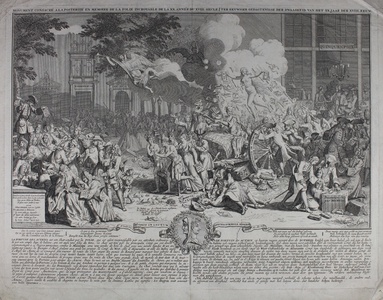| Method | Copper engraving and etching |
| Artist | Bernard Picart |
| Published | B. Picart fecit 1720 |
| Dimensions | Image 213 x 355 mm, Plate 279 x 368 mm, Sheet 305 x 385 mm |
| Notes |
A satirical depiction of the chaos that ensued in France as a result of the Mississippi scheme set up by John Law, also known as the "Mississippi Bubble". The full title reads: Monument consacré à la postérité en mémoir de la folie incroyable de la XX année du XVIII. siècle/ Ter eeuwiger gedagtenisse der dwaasheid van het XX jaar der XVIII. eeuw John Law (1671-1729) was a Scottish born economist. He studied in London, but fled the city for Amsterdam after he had fatally injured his adversary in a duel. He continued his studies in Amsterdam, and only ten years after the incident, returned home to Scotland, where he put forth his proposal for a banking reform, which was rejected. He then tried his luck elsewhere en eventually got permission to try the reform in France, where the government was in debt due to Louis XIV's spend drift, and Law had also befriended France's regent, the Duke of Orleans. His theory was that increasing the quantity of money on the market, would stimulate the economy at large. His plan was to found a central bank, which would manufacture bank notes to circulate in large quantities, instead of the rare gold and silver coins which where currently on the market. He founded his Banque Générale (General Bank) in 1716, for this purpose, in Paris, which would eventually lead to him taking over the minting process for the country, as well as the collection of taxes. A year later, he founded the Compagnie d'Occident (Company of the West), initially known as the Louisiana Company and later Compagnie des Indies, with the permission to develop the French territories in Mississippi, which he funded through his bank. Law eventually managed to also monopolise the French trade of African slaves and tabacco, and effectively controlled both the countries colonial trade and finances. The public saw the potential for the profits of Law's endevours in Mississippi, and wanted to buy shares of the Compagnie des Indies. This high demand for the shares, pushed the price of shares up drastically, out of proportion to the companies profits. Law intended to sell his shares in exchange for billets d'etats (state-issued public securities), and as these also rose in value, the European stock market had a sudden boost through the public speculating wildly. The French government responded by demanding more paper money to be printed at a fast rate, eventually resulting in the value of money to sink, as well as the value of Law's company shares and the billets d'etats. At he same time the Comoagnie des Indies did not make as much profit from its colonial ventures as quickly as expected, and because the company and the countries finances where tied, all of this ended in a crash of the stock market in 1720, not only in France, but throughout Europe. Although Law was not entirely responsible for everything that led to this disaster, he had to flee France and died a poor man in Venice. The French government took over the debt of the general bank and Compagnie des Indies and raised taxes to solve it. This historical event is satirised here, with and angel of the apocalyps blowing the trumpets, the devil blowing bubbles referring to the "Mississipi Bubble", Lady Fortune is standing on top of a chariot handing out shares, snakes and fool's hats. The chariot is pulled by people representing the colonial effort in Mississipi and the Compagnie des Indies, under the supervision of madness driving the chariot, and pushed by a few men, tugging at the wheel of commerce which has the names of several European cities of written on the spokes. Behind people are gathered at "Quinquenpoix", which is also the name of the street in Paris where John Law established his general bank in 1716, and the name of a coffee house in the trade district of Amsterdam. In the background, crowds of people are being led through three entrances into a hospital, a mad house, and house for the poor. On the left, people are gathered around a man handing out projects for a trade company, while on the right, a few people are paying an attorney to secure their best interest, and two men are fighting in the foreground over a bank contract. Extensive descriptions below the image in French and Dutch, as well the title above. Bernard Picart (11 June 1673 – 8 May 1733), was a French engraver, the son of the engraver Etienne Picart. He was born in Paris and worked in France and the Netherlands. Following the death of his wife in 1708, he moved to The Hague and later Amsterdam in 1711 where he became a Protestant convert and married again. His wife became his sales agent and had a reputation for her hard bargaining. Most of Picart's work were book-illustrations, including the Bible and Ovid. His most famous work is Cérémonies et coutumes religieuses de tous les peuples du monde. Jonathan I. Israel calls Cérémonies "an immense effort to record the religious rituals and beliefs of the world in all their diversity as objectively and authentically as possible". Israel notes also that Picart left Paris with Prosper Marchand, and collaborated on the Cérémonies with Jean-Frédéric Bernard, with a commitment to religious toleration. Picart, Marchand and Charles Levier belonged to a "radical Huguenot coterie". Dimier 1928, 560; Atlas van Stolk 3482-27 Condition: Centre folds as issued. Slight creasing to corners of the sheet. Overall time toning. Woodworm to lower centre. |
| Framing | unmounted |
| Price | £450.00 |
| Stock ID | 47735 |

